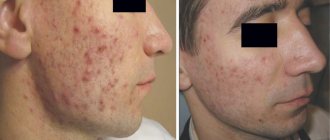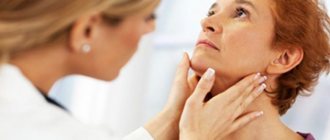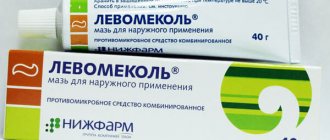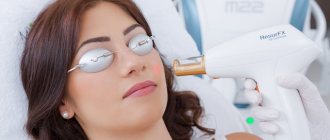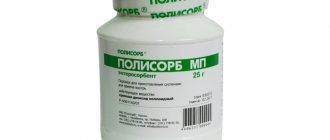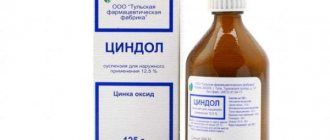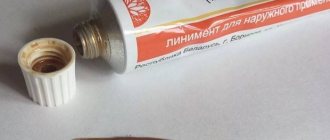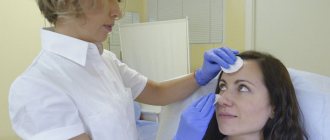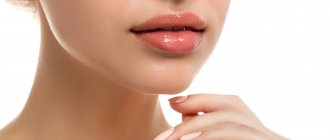The drug Doxycycline is an antibiotic of semi-synthetic origin and belongs to the tetracycline group of drugs.
It has a wide spectrum of action and is prescribed for many infectious diseases and lesions of various organs and systems of the body.
One of the common reasons for using Doxycycline is the regular appearance of a large number of pimples. Treatment with this drug becomes possible after agreeing on the course with a specialist.
Description of release forms and composition
The main active component of the drug Doxycycline is the substance of the same name – doxycycline.
It is thanks to its effect that various types of infections are eliminated, and positive results are achieved in the fight against acne.
Doxycycline can be purchased at pharmacies in the following forms:
- Oral capsules - each capsule contains 100 mg of doxycycline hydrochloride;
- Powder - intended for self-preparation of an injection solution.
When treating acne, only Doxycycline is used in capsule form, each package contains 10 or 20 pieces.
The principle of action of the drug and beneficial properties for the skin
The effectiveness of the drug is ensured by doxycycline hydrochloride, thanks to this substance, bacterial microflora is destroyed, while the drug does not affect fungal infections and viruses.
After its application, the following action mechanism is launched:
- Rapid absorption through the gastrointestinal tract;
- Penetration into bacterial cells;
- Suppression of protein synthesis processes;
- Termination of bacterial activity.
The following properties of Doxycycline help solve acne problems:
- Destroying pathogenic microflora in the intestines and normalizing its functioning. Infectious diseases of the digestive system often provoke the appearance of acne, so it is necessary to eliminate not the secondary symptoms, but the main cause;
- Detrimental effect on microorganisms sensitive to the composition and located in the upper layers of the epidermis;
- Providing natural protection and minimizing the risk of secondary infections that can aggravate the acne problem;
- Detrimental effect on subcutaneous mites , if the appearance of acne and general deterioration of the skin is associated with the pathological activity of this parasite.
Indications for use
The use of Doxycycline is possible not only for the treatment of skin rashes on different parts of the body, such as the back, head and face, but is also necessary in the acute course of infectious diseases.
The main indications are:
- Syphilis;
- Various types of chlamydia;
- Various forms of diphtheria and typhus;
- Inflammation of the gallbladder;
- Burns and open wounds when secondary infections are introduced into them;
- Purulent and necrotic skin lesions caused by pathogenic bacteria;
- Foci of purulent lesions in soft tissues, including the formation of abscesses;
- Inflammation of the urethra or bladder;
- Infectious lesions of peripheral joints;
- The risk of purulent inflammation during the rehabilitation period after surgical interventions.
Results
Doxycycline is a primary acne treatment that has been shown to effectively treat acne and is a component of the first-line treatment regimen for moderate to severe inflammatory acne.
As part of the tetracycline class, it may be superior to other antibiotics due to its antibacterial and anti-inflammatory properties.
A review of numerous clinical trials found that doxycycline successfully reduced up to 75% of inflammatory acne lesions and up to 54% of comedones (blackheads and whiteheads).
Doxycycline is not an effective treatment for acne scars because they are no longer actively inflamed.
How long does it take to get results?
Optimal combination therapy of doxycycline, benzoyl peroxide, and a topical retinoid can lead to improvement in as little as 2 weeks. However, some people may take up to 12 weeks to see improvements.
How to take it correctly to fight acne?
Doxycycline capsules are suitable for treating acne. The attending physician can always make adjustments to the treatment regimen depending on the state of health, the causes of acne and the severity of the symptoms.
Standard dosage regimen for adult acne patients:
- On the first day, take 2 tablets: morning and evening;
- Starting from the second day, you need to take 1 tablet per day;
- 200 mg of doxycycline is the maximum permissible daily dosage;
- The duration of the course is determined individually, taking into account the positive dynamics, the number of pimples and the causes of their occurrence. Treatment can last from 1 week to 1.5 months.
In case of a large number of pimples or their acute inflammation, take 2 tablets per day throughout the course.
Preparatory procedures before external use of Doxycycline
External use of Doxycycline is also practiced to solve problems associated with acne.
In this case, you will need to go through some preparatory procedures:
- Wash the affected areas of the skin with warm water , using mild soap or any neutral skin care product;
- The washed area of skin must be dried , but avoid putting excessive pressure on it, so it is best to lightly blot it with a soft towel or napkin, and then let it air dry naturally;
- Preliminarily spot treat acne with hydrogen peroxide using a cotton swab.
- Make sure there are no contraindications for the use of Doxycycline;
- To do an allergy test - to do this, dilute one capsule with a few drops of water, apply the resulting paste to your wrist for 20 minutes, then rinse. If no unpleasant symptoms occur, you can safely use the antibiotic externally.
How does doxycycline work in treating acne?
Doxycycline helps treat acne in several ways. It prevents the growth of acne-related bacteria, Cutibacterium acnes (formerly Propionibacterium acnes). By inhibiting the proliferation of C. acnes, doxycycline helps restore the balance of the skin microbiome. The microbiome is the trillions of microorganisms invisible on the skin that keep skin healthy.
Doxycycline also has anti-inflammatory properties. By inhibiting certain pro-inflammatory enzymes and acting as an antioxidant, it can reduce inflammation associated with acne.
Doxycycline-based masks
The best way to fight acne with Doxycycline is to use masks at home.
Standard mask based on Doxycycline and cosmetic clay
Doxycycline is used as an auxiliary component for various masks to reduce the number of acne.
Below is a recipe and method of using a standard product based on this drug and cosmetic clay:
- Take 1 tablespoon of any cosmetic clay and dilute it with water to obtain a thick paste;
- 5 Doxycycline tablets are crushed to a powder and added to the composition;
- The components are thoroughly mixed, the resulting homogeneous mass is applied to the face in even layers;
- You must wait until the mask has completely dried, after which it can be washed off with warm water;
- The course is required for 3-4 weeks, the procedure is carried out 2 times a week.
Cosmetic clay contains a large amount of minerals and substances beneficial to the skin; adding Doxycycline to it increases the antiseptic properties of the product.
Egg mask with the addition of Doxycycline
Egg masks are suitable for treating acne on dry skin. They normalize impaired metabolism and stimulate the natural protective functions of the skin. After using the product, color improves, skin elasticity increases and pigmentation is eliminated.
The recipe for preparing and using such a mask is as follows:
- Take 1 raw chicken egg, which will need to be beaten and then mixed with powder obtained from several capsules of Doxycycline;
- As additional components, use 1 teaspoon of olive or wheat oil, 10 grams of potato starch. After introduction into the composition, the mass is thoroughly mixed;
- The mass is applied in equal layers to the affected area, it can be washed off after 15 minutes;
- Depending on the degree of damage, you can take a course for 3 weeks with 2 procedures per week or a week course, applying masks to the affected areas daily.
The addition of Doxycycline to the composition allows you to eliminate various infections located in the upper layers of the epidermis and provide protection against their reappearance.
Milk mask with the addition of Doxycycline
There are various options for milk masks; the recipe discussed below is suitable for treating acne on oily skin.
The use of the product is recommended if acne occurs due to increased activity of the sebaceous glands, since the mask helps normalize their work.
The effectiveness is enhanced by the addition of Doxycycline, which will provide reliable protection against the addition of infectious microflora.
You can prepare and apply the mask using the following recipe:
- It is necessary to mix 2 ground Doxycycline capsules with 20 grams of flour;
- About 50 ml of milk is added to the dry mixture to make a thick paste; to prepare a mask, it is recommended to choose a product with a reduced fat content;
- At your discretion, you can add a small amount of any essential oil or spices to enhance the effect;
- The thoroughly mixed mass is evenly applied to areas of skin with acne.
- After 8 minutes, rinse off the mask with warm, clean water;
- The procedure can be performed 1-2 times a week, the course duration is 1-1.5 months, depending on the presence of positive changes.
What to do at the purging stage
As with other acne medications, your symptoms may get worse in the first 4 to 6 weeks of treatment before they get better. This is called cleansing and occurs due to increased skin cell turnover and accelerated release of deep-seated comedones.
Be especially gentle with your skin at this stage to avoid further irritation. Avoid all abrasive skin care products and opt for a sulfate-free cleanser and a light moisturizer.
You should not stop taking doxycycline without consulting a professional. If symptoms persist or worsen, consult a dermatologist.
Follow a few simple rules to prevent further skin irritation during this time:
● Do not touch or break out the lesions; avoid touching your face completely to maintain good hygiene
● Avoid heavy makeup and skin care products for oily skin, which can aggravate acne.
●Change your pillowcase regularly to prevent oil and debris from getting on your face.
● Maintain your skin care routine to clear out oil buildup from your pores.
Doxycycline based chatter
In the treatment of acne, a mash based on Doxycycline and Dimexide is highly effective.
Thanks to the combined action of these drugs, the following results can be achieved:
- Elimination of pathogenic microbial and bacterial microflora;
- Reducing inflammation;
- Elimination of pain;
- Acceleration of healing of damaged tissues;
- Less pronounced fibrinolytic effect.
Instructions for preparing and using mash are described in detail below:
- 20 Doxycycline tablets are crushed to a powder;
- The powder is dissolved in a liquid mixture - 150 ml of distilled water or injection solution and 50 ml of Dimexide in the form of a solution;
- Mix the resulting product thoroughly ; it is recommended to keep it in a transparent container;
- Before the first use, the mixture should sit for 24 hours ; the container should be shaken periodically;
- The mash is used to treat areas of skin with acne 2 times a day , in the morning and evening hours;
- After each use of the product, the skin must be treated with a cream with a moisturizing effect;
- The duration of the full course is 3 weeks , after which you must take a break.
How to use
Doxycycline should not be taken as a stand-alone acne treatment for several reasons. While it's effective against breakouts and bacteria, it can't do much to eliminate oil, debris, and dead skin cells—the stuff that clogs pores and causes blemishes.
Adding other medications, such as topical retinoids and benzoyl peroxide, can work together with doxycycline to clear blocked pores. Finally, using doxycycline with non-antibiotic drugs reduces the risk of developing antibiotic resistance.
You will likely be prescribed doxycycline for 3 months, and then your dermatologist will review your treatment depending on the severity of your acne and how your skin reacts. Some patients may require a longer course of doxycycline.
Dosage
The typical dose of doxycycline for acne is 50–100 mg twice daily or 100 mg once daily. Because it can cause stomach upset and digestive problems, it should be taken with food.
Concerns about the emergence of antibiotic-resistant strains of bacteria have led some experts to suggest lower doses—20 mg twice daily or 40 mg once daily. In this range, doxycycline retains its anti-inflammatory effects and has proven effective against mild inflammatory acne.
Use during pregnancy and lactation
Pregnancy at any stage is a direct contraindication for the use of Doxycycline, since the substances of the drug are able to cross the placental barrier.
Violation of this prohibition can lead to the following developmental disorders of the fetus:
- Pathological accumulation of fat in liver cells;
- Pathologies of dental development;
- Exhaustion and lack of normal development of the musculoskeletal system.
The active ingredient of the drug can penetrate into mother's milk, so lactation will also be a contraindication. If there is an urgent need to use the product, breastfeeding should be stopped.
During pregnancy, Doxycycline can be used externally, but under the strict supervision of a dermatologist.
Use in childhood
The drug can be used to treat children over 12 years of age. In case of urgent need, Doxycycline can be prescribed for the treatment of children over 8 years of age under the supervision of a pediatrician.
When using the product in childhood, changes are made to the dosage regimen:
- On the first day of treatment , the dosage is calculated from the ratio of 4 mg of active substance per 1 kg of child’s body weight; the received dose is divided into 2 doses;
- Starting from the second day , the calculation is based on the ratio of 2 mg per 1 kg of the child’s body weight; reception is also carried out 2 times a day;
- The duration of the course is determined by the doctor and can range from a week to a month ; in the case of children, treatment must be reduced as much as possible.
Children over 14 years of age can use the drug according to the same regimen as for adult patients. If your body weight is less than 45 kg, the drug is not prescribed, regardless of age.
What is doxycycline
Doxycycline is an oral antibiotic that belongs to a class of drugs called tetracyclines, which are broad-spectrum antibiotics. This means they can kill a wide range of bacteria, making them effective against infections such as pneumonia and chlamydia.
Doxycycline also has anti-inflammatory properties and is commonly prescribed to treat rosacea, also known as adult acne.
This antibiotic can also effectively kill infections caused by gram-positive and gram-negative bacteria.
Special instructions for the use of Doxycycline
Before using Doxycycline, you should familiarize yourself with the following additional instructions:
- To facilitate the administration and absorption of the drug, capsules should be washed down with boiled water or low-fat milk;
- As an addition to the drug, antihistamines may be prescribed to prevent an allergic reaction;
- Additional use of drugs with probiotics and prebiotics is recommended , since antibiotics have a detrimental effect on the intestinal microflora;
- When completing the course, it is recommended to stop eating fermented milk products and drink plenty of water;
- When using the drug to treat acne, it is recommended to avoid exposure to direct sunlight and also avoid visiting solariums;
- The intake must be carried out in strict accordance with the instructions of the attending physician ; it is not allowed to take breaks or exceed the prescribed dosage.
Methods of application
The medicine is applied externally, usually as part of talkers. Before application, wash with warm water. You can use soap, tonic, lotion or gel. Then you need to dry the skin, it is better to do this with a disposable paper towel. There are also several effective and proven mask recipes.
Doxycycline masks
Doxycycline masks will help you in the fight for the beauty of your skin, improve its condition and appearance. To obtain maximum effect, we recommend that you follow the proportions and maintain the required application time.
With aloe
This mask is used for severe rashes over a large area of the face. This mask can be applied to acne on the back, inflamed hair follicles and subcutaneous pimples on any part of the body.
To prepare you will need to take:
- 5-6 capsules AEvit;
- A few drops of aloe juice;
- 1 tsp decoction of chamomile or linden flowers;
- 3 tbsp water;
- If your skin is oily, you can add 1 teaspoon of white or blue clay.
Stir to a mushy consistency. Apply to the entire face or individual areas where rashes are present. Leave for 15 minutes, rinse with warm water and wipe skin with tonic. Repeat the procedure 2-3 times a week. This product is recommended for use when multiple pimples and comedones appear.
With hydrogen peroxide
To prepare this excellent product, take:
- 4 antibiotic capsules;
- 2 tbsp of any clay;
- 2 tbsp baby powder or talcum powder;
- Add 3% hydrogen peroxide or chlorhexidine until a paste forms.
Now the resulting composition must be stirred and left for 15-20 minutes, which can then be washed off with warm water. This combination is perfect for those with oily skin prone to constant breakouts.
Doxycycline talkers
Doxycycline mash has a strong drying and antimicrobial/antibacterial effect. The recipe for such talkers can vary greatly depending on the requirements and the reaction of inflammation to drugs, but the most important component remains unchanged - the antibiotic doxycycline.
Contraindications
You will have to refuse acne treatment with Doxycycline if you have the following contraindications:
- Pregnancy and lactation;
- Body weight less than 45 kg;
- Age under 12 years;
- Poor lactose tolerance;
- Impaired absorption of monosaccharides in the gastrointestinal tract;
- Pathologies of pigment metabolism with increased concentrations of porphin in the blood;
- Reduced content of leukocytes in the blood;
- Kidney diseases in severe form or at the acute stage;
- Intolerance to the active substance or the occurrence of side effects when taking other antibiotics from the tetracycline group.
Alternative options
Antibiotic therapy is the cornerstone in the treatment of acne. Other antibiotics that have proven effective against acne include macrolides, trimethoprim, and other members of the tetracycline family.
Tetracyclines
Like doxycycline, minocycline and tetracycline (named after the group) are effective treatments for acne. (Doxycycline and minocycline have replaced the older tetracycline as the drugs of choice for severe to moderate acne.)
Doxycycline and minocycline are comparable in effectiveness; however, doxycycline is less likely to cause side effects such as gastrointestinal upset.
Macrolides
Macrolide antibiotics such as erythromycin and azithromycin are effective treatments for acne and have significant anti-inflammatory effects. Macrolides are prescribed as an alternative to people who cannot take doxycycline due to allergies or serious side effects, pregnancy, or young age.
Trimethoprim
Although trimethoprim-sulfamethoxazole (TMP-SMX) is an effective antibiotic for acne, the potential for serious side effects such as bone marrow suppression and TEN limits its use.
With this in mind, TMP-SMX is recommended as a third-line antibiotic for the treatment of resistant acne or for those who cannot take tetracycline antibiotics.
Side effects
When taking Doxycycline there is a risk of the following side effects:
- Metabolic disorders and the development of anorexia;
- Increased levels of intracranial pressure and disruption of the central nervous system;
- Deterioration of appetite and changes in the state of natural microflora;
- Headache and tinnitus.
- Complex disorder of the digestive system, as well as nausea and diarrhea;
- Allergic reaction and urticaria;
- Changes in the chemical composition of the blood and an increase in nitrogen content in urea;
- Muscle and joint pain, aching sensation;
- Changes in the color of tooth enamel and gum sensitivity;
- Increased sensitivity to bright light and tearing.
Is it possible to overdose?
If the permissible dosage of Doxycycline is exceeded, the following reactions occur:
- Neurotoxic effects on the liver;
- A sharp increase in intracranial pressure;
- Profuse vomiting;
- Convulsive reaction.
A specific antidote has not been developed; in case of overdose, the following measures must be taken:
- Immediate discontinuation of the drug;
- Artificial induction of vomiting;
- Gastric lavage;
- Taking activated carbon;
- Taking magnesium sulfate;
- Taking pharmacological drugs belonging to the group of antacids.
If any signs of overdose occur, it is recommended to seek medical help.
Interaction and incompatibility with other drugs
The simultaneous use of Doxycycline and the following drugs with which it interacts undesirably is prohibited:
- Antibiotics belonging to the tetracycline group;
- Medicines with an alkaline environment or an environment with reduced stability;
- Any medications that contain magnesium, iron or calcium.
Other drug interactions are described below:
- When taking retinol-based drugs, the risk of changes in intracranial pressure increases;
- When taking drugs based on methoxyflurane, the risk of renal dysfunction increases; there is a threat of death;
- When taking drugs based on rifampicin or containing ethanol, the effectiveness of Doxycycline is reduced;
- Reduced effectiveness of antibiotics based on penicillin or cephalosporin.
Simultaneous use with indirect anticoagulants requires additional coordination with the attending physician; due to the nature of the effect, individual dose adjustment is often necessary.
Possible analogues
In some cases, when the use of Doxycycline is impossible, one of the following drug analogues may be prescribed:
- Unidox Solutab - produced in Holland, available in the form of tablets based on doxycycline. The cost is 300-350 rubles ;
- Vibramycin
- has a similar composition; the concentration of the substance in tablets can be 100 and 200 mg.
The average cost of the drug is 530 rubles .
Unidox Solutab Vibramycin
All analogs of the drug, like Doxycycline, can be purchased in pharmacies only if prescribed by your doctor. Self-prescription of the drug is not allowed.

